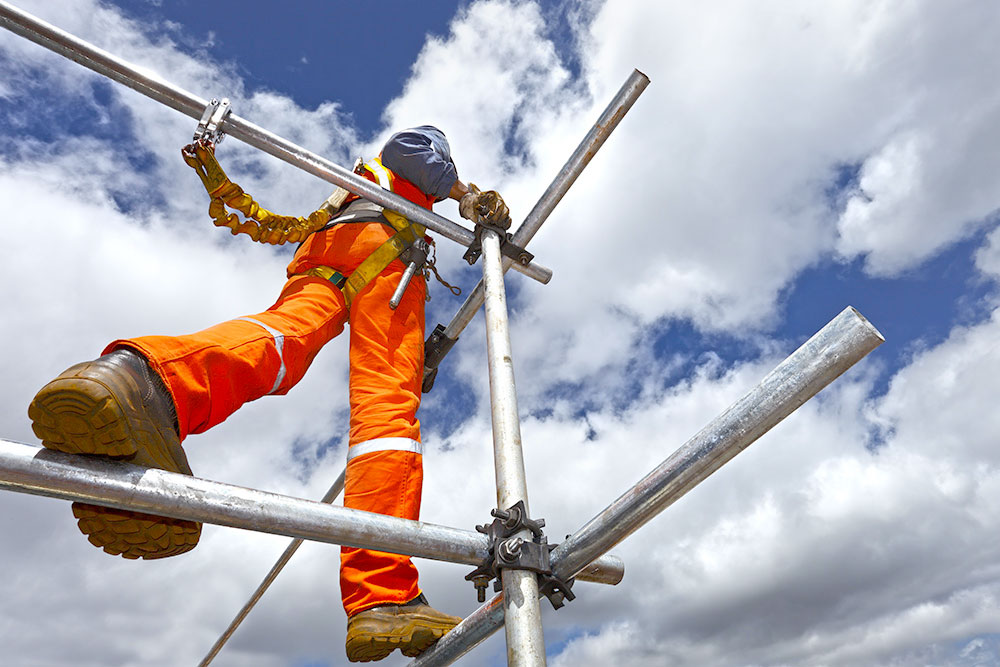Approximately 2.3 million U.S. construction workers — or roughly 65% of our construction industry — work on scaffolds.
While these temporary elevated platforms help workers elevate themselves, materials, and equipment each day, they can also put workers at risk for injury or death if not used properly.
According to the United States Bureau of Labor Statistics (BLS), scaffold-related accidents result in roughly 4,500 injuries and 60 deaths each year. Those deaths account for roughly one-quarter of all fatal falls from all working surfaces.
These tragic accidents are preventable, however.
Safe Setup and Use
Employees should always remember that scaffolds aren’t permanent structures, and safety must be the top priority when constructing and working on them.
The scaffold must be placed on a solid, level base during setup.
The scaffold’s footing features a wooden pad (called a mudsill) that rests atop the ground or floor area, which usually consists of concrete or dirt. There is also a base plate on top of the mudsill. This 6-inch square steel footing component goes under the scaffold post. The base plate and mudsill help distribute the scaffold’s load, so each leg’s pressure is reduced.
Scaffold designers need to communicate with workers before a scaffold is designed and constructed to use it in the way it was intended. Scaffolds also must be examined before use by qualified personnel to ensure that:
Access on and off the unit meets OSHA requirements.
- All work areas are fully planked or decked (Planking should extend all the way across with a maximum allowable gap between planks of 1 inch, per OSHA guidelines)
- Guardrails and/or alternative fall protection are installed properly
- The unit is properly guyed and tied to the building, and all guys and ties are in good condition
Workers should never climb the scaffold itself but rather use a ladder next to or built into the structure.
Also, while workers might feel constrained while working on the structure, removing bracing from the scaffold can make the structure unstable and, if multiple pieces are removed, cause it to collapse.
Perhaps most importantly, workers should remember where they are at all times and move slowly and with extra caution while working on a scaffold. Even if the scaffold is secure, it’s not the same as working on the ground.

Fall Prevention
Falls are one of the biggest hazards associated with working on scaffolding. While OSHA’s trigger height for mandated fall protection is 10 feet above lower levels, fall protection should be provided for workers at any height. Not only can fall from heights as low as 6 feet result in a serious injury or fatality but falls on the same level can also cause injuries.
Assuming the entire standing surface has been laid down with no gaps, a guardrail can satisfy fall protection compliance on a fully planked or decked scaffold. With that said, since workers often have to reach out past protection measures to grab equipment or perform tasks, all workers on any type of scaffold should also use a personal fall arrest system.
Experts warn that just because a scaffold feels solid, workers need to remember that it is still a temporary structure. If they don’t tie off and then walk near an opening, they put themselves at risk of falling to the next level.
Some models, like swing scaffolds, require guardrails and personal fall arrest systems. And while OSHA technically doesn’t require tying off in some situations during erection or dismantling, many companies require tying off in all circumstances.
Workers who use personal fall arrest systems – or tie-off – should know where to set their anchors. Different scaffold types may have different points on which anchors can or cannot be attached. Scaffolds can be used only as anchorage if they meet safety requirements and are built to withstand the forces applied when someone falls.
Preventing Struck-bys
Workers on and around the scaffold are at risk of being struck by falling objects. Just because the scaffold planks above them shield workers on lower levels, that doesn’t mean they are completely safe.
Workers can become injured by falling or dropped objects whenever they reach or lean outside the scaffold. Falling tools or other objects can also collide with other objects or the scaffold itself, causing them to change direction and put workers under the planks — or as far as 30 horizontal feet away — at risk.
Toeboards should be in place to keep objects from falling. OSHA also requires paneling or a screen extending up to the guardrail to secure tools or equipment piled higher than the top of a toeboard. Nets and tethered tools are also an industry standard for preventing falling equipment.
Also, keeping workplaces clean can prevent tripping hazards and keep tools, building materials, or other objects from being knocked off scaffolds.
Proper Material Handling
Basic material handling practices are key for preventing ergonomics-related injuries on scaffolding.
Workers should be familiar with proper lifting techniques. Scaffold erectors often have to move large, bulky pieces of material, so they should get a good grip in the center of the material with their hands spread apart for maximum control. If they’re moving substantial pieces of material, they should enlist their coworkers’ help.
 While many employers use mechanical devices to haul equipment up and down scaffolds — instead of workers using a “daisy chain” method — workers can still be hurt even if they’re not lifting anything. In all cases, work areas should be barricaded to keep people out and safe.
While many employers use mechanical devices to haul equipment up and down scaffolds — instead of workers using a “daisy chain” method — workers can still be hurt even if they’re not lifting anything. In all cases, work areas should be barricaded to keep people out and safe.
Other Hazards
Wind can be a serious issue on higher elevated scaffolds. Not only can workers struggle with movement, but wind can also cause them to drop large objects. OSHA guidelines call for workers in high-wind situations to use personal fall arrest systems in addition to guardrails or to install windscreens.
Scaffolds can bring workers dangerously close to power lines, too. To avoid electrical injuries, OSHA requires 10 feet of clearance between 300 volts or more power lines and everything on a scaffold, including all workers and materials.
Lastly, workers need to know their scaffold’s load limit. Scaffold platforms come in three uniform loading categories — each with its own weight limit per square foot. Workers will need to know their weight, as well as the weight of all the materials and tools they’ll be bringing with them.
While some workers — like bricklayers or masons – commonly overload scaffolds by bringing up a lot of material at once, this can overload the scaffold and exceed its weight limit, potentially leading to a collapse. To avoid this, workers should be sure to stay under all weight limits and only get supplies as needed.
Renting or leasing typical metal scaffolding for semi-permanent or longer-term applications has many disadvantages. Some are just downright unsafe if not installed correctly — not the least of which is that scaffolding must be reinspected and re-certified regularly. This can create time delays and costly fines if not performed on time. Learn why ErectaStep can serve as an even better alternative to all types of semi-permanent to permanent scaffolding.


























